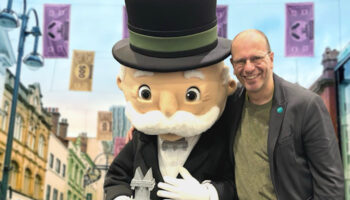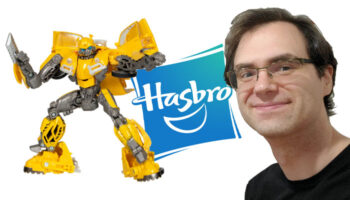“Houston, we’ve had a problem.”

Exactly fifty years ago to the day – April 13, 1970 – Apollo 13 astronauts James A. Lovell and John L. Swigert both said these words to NASA Mission Control.
Usually misquoted in the present tense, the sentence marks the start of one of the most extraordinary stories of creativity on or off the face of the planet…
But what’s this got to do with toys and games? The epic story of Apollo 13 – NASA’s most successful failure – teaches seven valuable lessons about creativity in ANY industry! So: here’s a story with seven lessons, three astronauts and one remarkable journey…
The Dry-But-Necessary Background…
Launching on a mission that some described as “routine”, Apollo 13’s
April 11th liftoff took place at 13:13. This time was chosen deliberately, it’s noted, to cock a snook at the idea that the number 13 was unlucky…
Aside from the Saturn V rockets that carried it out of Earth’s atmosphere, the actual ship comprised three main sections: the cylinder-shaped Service Module, housing the engines and ‘workings’ of the ship; the conical Command Module, from which the crew controlled the mission; and the small two-man ship that would briefly travel to the Moon’s surface – the Lunar Module.

Once on the Moon, the Lunar Module would split in two… Having separated, half of it would remain behind to serve as a launch pad; the other half would fly back and dock with the Command Module. It would then be jettisoned and allowed to crash into the Moon’s surface.

The Hidden Problem
Weeks before the Apollo 13 crew rocketed out of Earth’s atmosphere, the ship’s number two oxygen tank – filled with liquid oxygen and carried in the Service Module – underwent transfer from the Apollo 10 spaceflight. Unbeknownst to engineers, a series of modification and maintenance procedures on the tank caused some of its internal wiring to become exposed.
So, in practical terms, the Apollo 13 mission was destined to fail not by superstition, but by this invisible error – it was like flying with a time bomb! Despite having one small engine ‘gremlin’ on launch, though, things continued smoothly for some time…
The Explosion
Indeed, it wasn’t until Houston asked the crew to stir the oxygen in tank two for the fifth time that trouble began… Sure enough, though, 55 hours, 53 minutes and 18 seconds into the flight, John Swigert flipped one fateful switch. In an instant, the faulty wires sparked, their insulation caught fire, the liquid oxygen exploded – and the catastrophic blast that resulted took out the ship’s main air, water, and power supplies.

The Seven Problems
As Houston’s instruments went doolally, the astronauts – now 321,860 km from Earth – calmly reported that they’d “…had a problem”. In truth, they still had one, and would have to overcome several more – and each was life-threateningly serious. The events that followed remain one of history’s greatest stories of creativity, determination and teamwork…
Problem One: Immediate Survival
The Command Module, in which the astronauts were flying, immediately and quickly began to run out of oxygen and power. It also had very little battery power: if the crew stayed put, they’d be dead within minutes.
Solution
The team began to transfer – by hand – essential data from the Command Module into the Lunar Module. Since that had its own supply of air, water and oxygen, they could use it as a lifeboat. While necessary, this solution in itself created issues, however, not least of which was that only the Command Module they were evacuating could re-enter the atmosphere of Earth.

Lesson
The crew’s evacuation to the Lunar Module was clearly an imperfect solution, but it kept the astronauts alive and bought them time to identify and assess the other problems. If you ever try ideating with people who aren’t quite on the same page as you, you’re bound to discover how clunky it is when someone starts trying to solve a problem that’s way down the line…
A great example of this would be an inventor that repeatedly spends time mocking up the packaging of an idea before the theme and gameplay are truly locked down. While one could argue that novelty packaging might help sell a game, and is certainly something that needs thought, it probably isn’t something that needs knocking up at the expense of playtesting.
The fact is that some issues need immediate action; others need a great deal more careful thought and research. Habitually-creative people tend to be aware of which kind of problem they’re trying to solve. They don’t get distracted by tiny details at the big-concept stage, and they understand, too, that it’s sometimes desirable to simply swap one problem for another…
Problem Two: Turning the Ship Without Using the Engine
As the crew transferred to the Lunar Module, they shut down the still-needed Command Module to conserve what little power it had for atmosphere re-entry back home… Presuming they’d make it that far.

For now, there was a more pressing problem: in order to turn their ship around quickly, the crew would have to use the engine on the Service Module. This was situated very near the source of the explosion and – if it was damaged – could easily fail or make things worse. Even a small error in the turn could result in the ship crashing into the Moon, or forever being lost in space…
Solution
In what sounds like the plot of a sci-fi movie, the crew was ordered to do the complete opposite of what seemed best. Instead of turning as soon as possible, they continued flying toward the Moon, using the Lunar Module’s less-powerful engine to maintain trajectory…
The idea was that the stricken ship could use the orbit of the Moon to help make the turn by performing a slingshot manoeuvre around it. While adding four days to the length of the return flight, it avoided using the suspect engine.
Lesson
The obvious idea may not be the best idea! After you have your first couple of ideas on any project, use ‘The Opposite Technique’. Simply ask yourself: “What’s the opposite of this idea?” This lets you not only double the number of ideas that you have, but also suggests hidden shades of grey between the black and white of the first two options.
In toys and games, it’s surprising how often doing the opposite of an old idea leads to a new one… By way of example, Bananagrams, Just One and Wonky Blocks are almost exact opposites of other ideas. If it’s the first time you’ve heard about this, Billy Langsworthy and I discuss it more in the book, ‘The Snakes & Ladders of Creative Thinking: How to Have More Ideas for Board Games, Improve Them, & Get Them Ready to Pitch.

Problem Three: Short Supplies
Remember the original plan for the Lunar Module? Two astronauts would use it to travel down to the Moon’s surface for a short time… Consequently, the Lunar Module was only equipped to support two men for about a day and a half. The new plan, however, forced three men in there for over four days! That meant the crew’s consumables – including power and water, which was critical to the ship’s systems – would run out before they got home.
Solution
They drank less, switched off as many systems as possible to save power, and wore all their underwear at once to battle the cold… In other words: they prioritised the ship’s needs – and made do!
Lesson
Sometimes, even the best solutions will do no more than get you by. But a make-do-and-mend answer is still an answer! Perhaps the best example of this is the story of how He-Man toys reached the market. It’s a fascinating story, and one that would take too much time to tell here in detail, but if you have Netflix, be sure to watch The Toys That Made Us – Season 1, Episode 3.
In a nutshell, you’ll see how the team pitching He-Man toys more or less bullshitted their way through the entire pitch. The audacity of it is jaw-dropping! And while I wouldn’t suggest anybody tries to do that in this day and age – on the contrary; I strongly advise integrity and clear communication – it is worth keeping this in mind… Whenever you deviate from intention, you are – by definition – being creative. This is why habitually creative people tend to be relaxed with uncertainty.

Problem Four: Round Pegs, Square Holes
An unforeseen consequence of having the entire crew in the Lunar Module for so long was that their breathing meant an excess of life-threatening carbon dioxide quickly began to build up. Unless the men could change the ship’s air filter, they would soon poison themselves. And while the Command Module did have more filters available, they were round in shape: the Lunar Module had square filters: the round ‘peg’ literally didn’t fit in the square hole…
Solution
Of all the dazzling things in this story, this is the one that makes heads spin, jaws drop and minds boggle… Back on Earth, the NASA team took a duplicate of every single piece of equipment that was aboard the ship, but that wasn’t absolutely essential for the landing… And jerry rigged a way to adapt the round filters to fit the square holes.
Lesson
Think inside the box! Sometimes it IS just better to be realistic with things you know for sure than to indulge in outlandish brainstorming! When they’re presented with practical limitations, many habitually-creative people roll their eyes and cluck their tongues in disappointment. For all of 10 seconds, they express real irritation at the limits that others put on them…
As quickly as that, however, they suddenly accept the necessity of certain limits, and start ideating excitedly within those parameters. Indeed, if you’re really stuck for ideas, you might have some success placing more limits on your thinking.
By way of example, I’ve had a few people mention to me recently that they’re irritated because the Covid 19 lockdown stops them progressing certain ideas. I asked them if they’d considered designing an original game that people can play over FaceTime or Zoom – one that uses only things that are guaranteed to be in every house… As a creative limit, the lockdown is what it is: it simply has to be accepted and worked around.
Problem Five: Lost in Space
As the astronauts approached Earth, the Apollo 13 crew was off course. The ship was set to hit the planet’s atmosphere and bounce right off it, before drifting into the depths of space. To correct their course without navigation equipment, the crew needed reference points. They also needed to fire the engines at precise moments without clocks since they had no power. For the first time, the ground crew couldn’t help…

Solution
The astronauts ingeniously suggested that there were two things they could use as fixed reference points: the Earth and the Moon! Keeping view of these by having one crew member eyeing each heavenly body through window frames, the third astronaut used his watch to time the firing of the engine.
Lesson
Always look at problems from different perspectives… From the point of view of Mission Control, there was simply no way to help the Apollo 13 crew navigate home. But that’s because they were on the ground… Up in space, the problem looked completely different! When trying to sell an idea, exploring how it looks from different perspectives is arguably more important than any other skill.
By far and away my favourite example of this is the Fantastic Factory game Stupid Deaths. From a snobby designer’s point of view, I’m sure this barely even looks like a game. There’s really not much to it: you more or less have to guess whether or not the unlikely scenarios with which you’re presented are true. Each scenario is a bizarre death: many are curious, others are hysterical – some are just poetic… It’s like The Gashlycrumb Tinies all grew up!

From the perspective of a retailer, however, this is a simple, funny, commercial game that just about any age can play… And look at the packaging – it’s an eye-catching masterstroke! In any case, there is NO stage of developing a toy or game that doesn’t require you to look at the idea from the perspective of others: end users, purchasers, distributors, retailers, shippers manufacturers and more.
Problem Six: Cold Start
Ever tried starting a car on a really cold morning? Not always easy! But it pales next to the idea of powering up a NASA Command Module – from near frozen – to run off a rapidly-draining battery, while still in flight! And though it was theoretically possible, even one small mistake during the start-up procedure could cost the crew their lives.
Solution
In advance of the critical moment, Ground Control ran test after test after test in its simulators to find ways to safely power up the Command Module and ensure the requisite power would be available. When the time came, NASA radioed its plan up to the astronauts to put into effect. It had over 500 steps!
Lesson
Successful ideas are the product of thought, research, hard work AND inspiration! The much-ballyhooed notion that great creativity happens in huge, spontaneous flashes is romantic and mostly nonsense. Even one of the most-often celebrated flash-of-inspiration stories – Sir Isaac Newton discovering gravity when an apple landed on his head – omits the facts…
First, Newton wasn’t struck by the apple: he merely saw one fall. Second, he didn’t immediately join all the dots between the falling apple and the force that stops us flying off the face of the Earth… On the contrary: while he contemplated it when he saw the apple fall in 1665, he didn’t publish his full theory until 1687. That’s a 22-year ‘flash’! Remember: the steps between having a idea and reifying it can be slow, arduous work.

Problem Seven: Damaged Shields
When the time came to jettison the Service Module so that the ship could re-enter the Earth’s atmosphere, the crew could see – for the very first time – the full extent of damage the explosion caused four days earlier. It was extreme, causing serious doubt as to whether the heat shield on the bottom of the Control Module would survive the severe conditions of re-entry…
Solution
None. They just had to take a chance. The chance paid off! All three astronauts splashed down safely, and lived to tell the extraordinary tale of NASA’s most successful failure.

Lesson
At some point, when you’ve done everything you can think of, and tried all the techniques and theory you know, you just have to get on with it. Stop refining the idea; stop playtesting it; stop loving it – and start pitching it. Right now, over the world, there are countless ideas that remain simultaneously finished and unfinished… Finished, because the inventor isn’t going to develop them significantly further… Unfinished because the idea hasn’t been used.
Final Thought…
Here’s something I find fascinating in relation to seeing things differently: you’ll recall the problem I mentioned earlier in regard to the explosion in the oxygen tanks being caused by the need to stir them? Well, it turns out that a sensor fault meant that the oxygen was purposefully being stirred unusually often during the flight. When the tank exploded, it wasn’t the first stirring: it was the fifth…
What difference does that make? Well, it gives us an interesting perspective. If the oxygen tanks had been stirred according to the original schedule, the fifth occasion would have coincided with the Lunar Module being on the surface of the Moon! The astronauts could never have recovered from that.
From that perspective, Apollo 13 really wasn’t anything like the disaster it could have been. Rather, you could say the crew was very, very lucky! And that leads us to one final thought about creativity and problem-solving: sometimes, what seems like a problem in one context turns out not to be a problem at all!
With thanks to: Charly Sommers, Bertie Gladstone, The Brothers Brick, David Snow, Asmodee, Bananagrams, Tactic Games, Netflix and LEGO.
—-
To stay in the loop with the latest news, interviews and features from the world of toy and game design, sign up to our weekly newsletter here
























